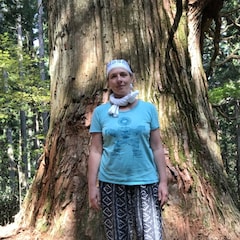In the Footsteps of Japan’s Yamabushi Ascetics
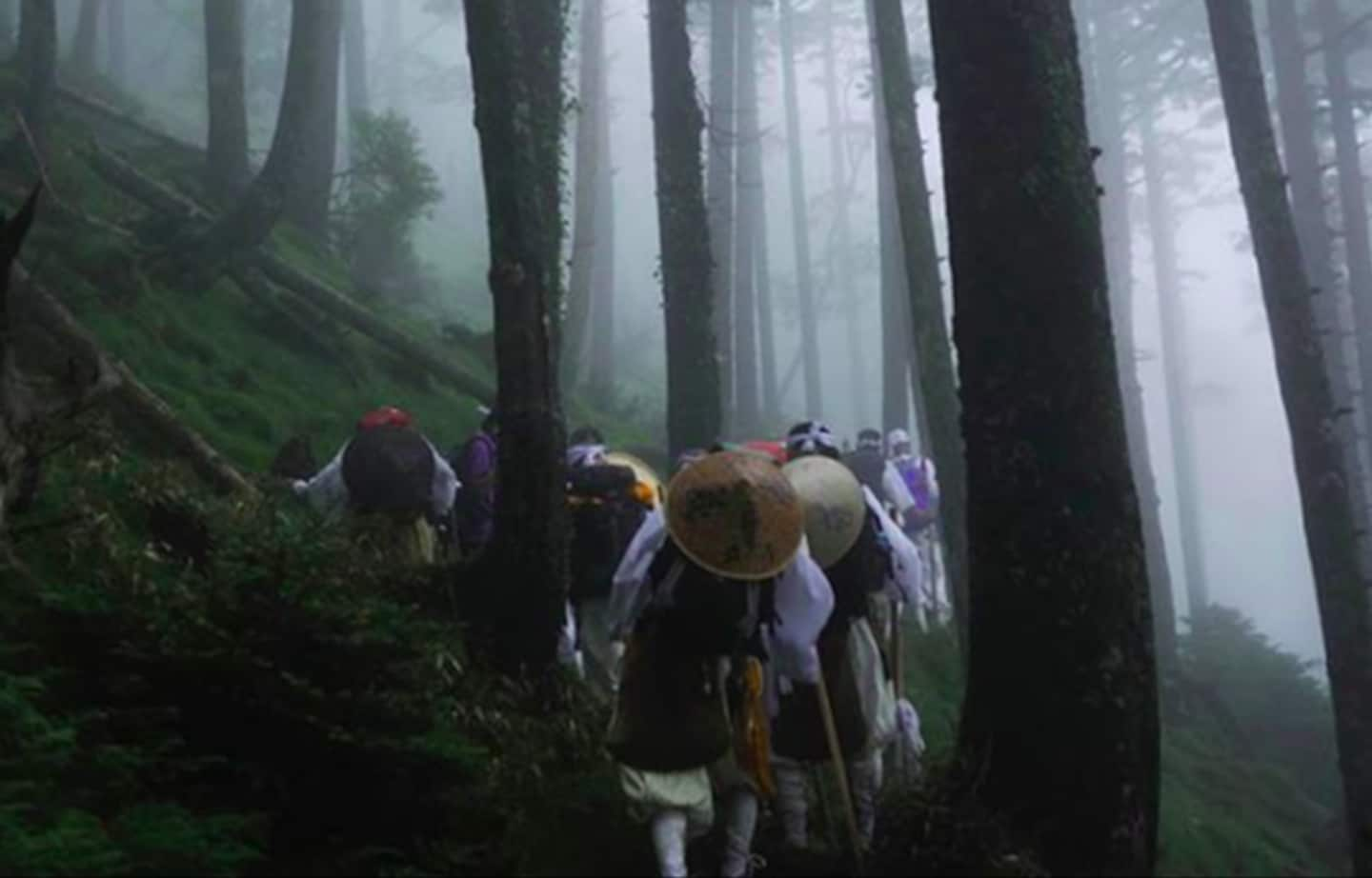
They seem to belong to a different time and place. They walk for days on remote trails on sacred mountains, robed in an archaic outfits. In one hand they carry a wooden staff and in the other a conch shell. They are Yamabushi, and viisitors can get a glimpse of them and their ascetic traditions in a small mountain village in central Japan.
By Alena Eckelmann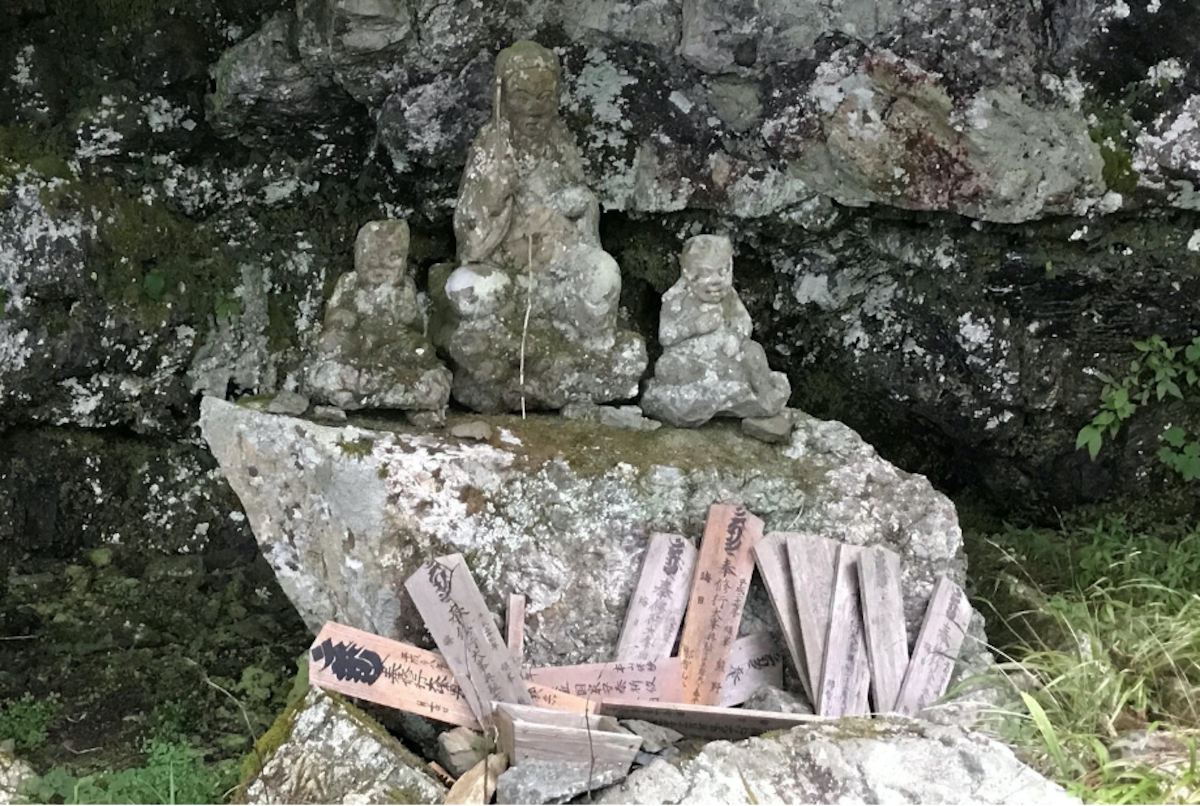
A stone carving of En the Ascetic, the founder of Shugendo in the hills around Yoshinoyama. He is usually depicted with his two attendants at his side. Zenki and Goki were an ogre couple that gave up their terrorizing ways. (Photo: Alena Eckelmann)
Shugendo is a spiritual tradition unique to Japan that goes back some 1300 years as a way (do) of training and ascetic discipline (shu) to gain spiritual power (gen). It combines elements from Shintoism, Esoteric Buddhism, Daoism and Folk Religion. The followers of Shugendo are called shugenja, but they are popularly called yamabushi, or “mountain worshipers,” because their ascetic training consisted of many months spent in harsh mountain environments.
Shugendo followers venerate a man named En no Gyoja, or En the Ascetic, as the founder. En was an ascetic monk, healer, and diviner who is said to have lived in the seventh century in the Katsuragi mountain range in central Japan. He became a prototype for all Yamabushi to follow.
Today, however, modern-day ascetics can hardly follow the extreme regimes of earlier practitioners. Many have families, and secular jobs, and can only spend a few days at a time in the natural wilderness. They become yamabushi by going through certain initiation rites and by taking up various ascetic practices, particularly the mountain treks known as mine-iri, or “entering the mountains.” But completing pilgrimages and mountain treks, the followers earn rank. Those of higher rank become sedatsu, who lead the mountain treks.
"The ascetic pilgrims walk the streets in single file, blowing their conch shells as they make their way to the mountains."
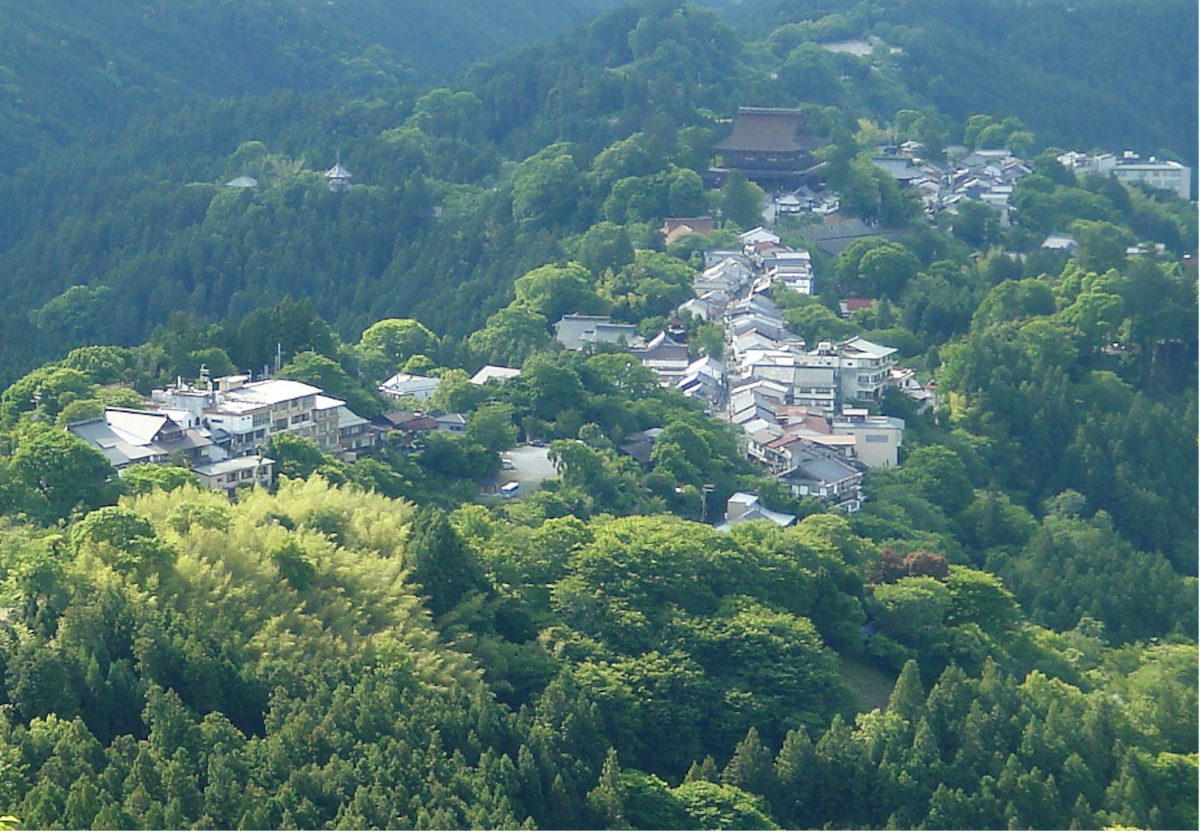
The village of Yoshinoyama stretches out over several kilometers from Yoshino Station to Kimpu Jinja shrine, a climb of 500 meters. (Photo: Alena Eckelmann)
For anyone interested in learning more about the believers and their practices, a visit to the village of Yoshinoyama, located deep in the mountains of Nara Prefecture, is highly recommended. Here Shugendo is very much alive.
Yamabushi are seen, and especially heard, in the village during the official mountain entry season, which runs from May 3 to September 23. They walk the streets in single file, blowing their horagai conch shells as they pass on their way to enter the Omine mountain range to carry out ascetic training. They stop at certain places to recite prayers, accompanied by the rhythmic rattling of their shakujo, a short ritualistic wooden staff. Wooden prayer plates called fuda are left behind as evidence that a group of Yamabushi have stopped and prayed there.
"You can book a meditation, sutra copying, or waterfall purification session."
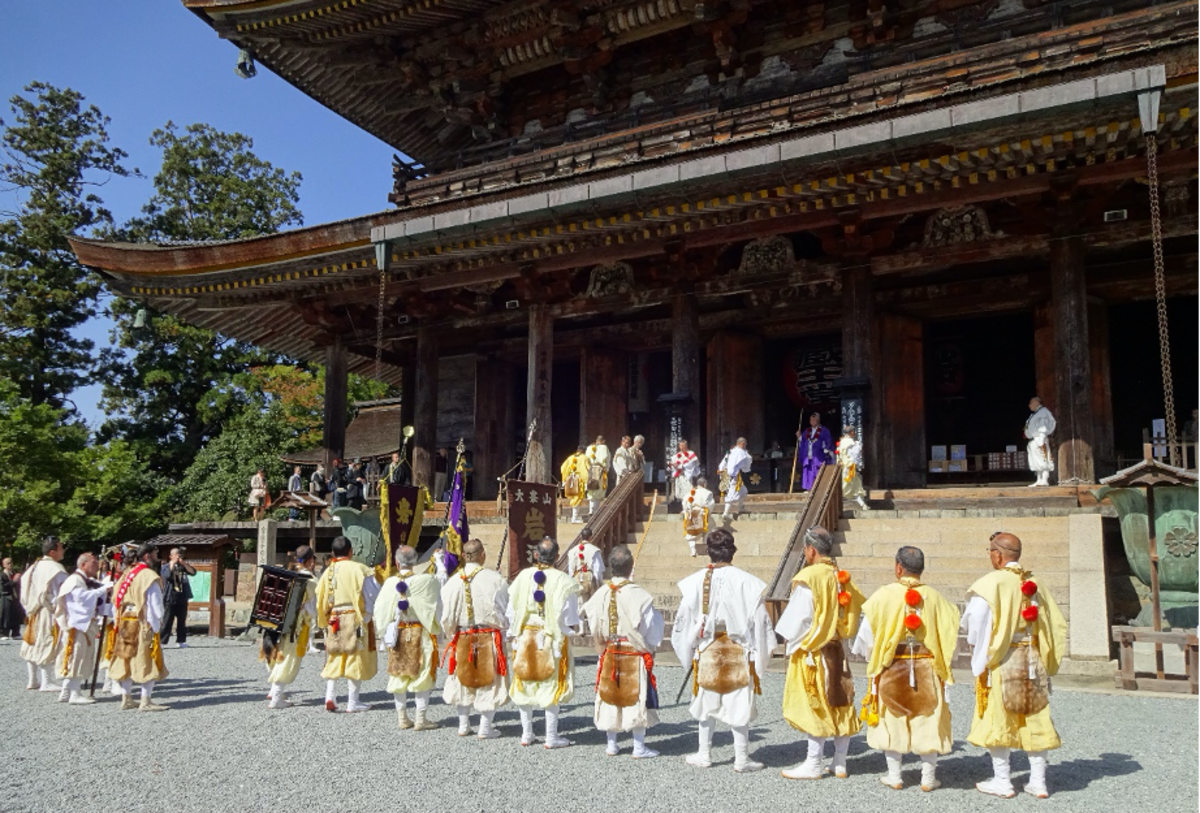
A group of Yamanushi arriving in front of Kimpusenji temple's Zao-do hall, operating to pray to Zao Gongen, the deity that is venerated here.
Besides getting a glimpse of the ascetics, a visit to one of the Shugendo temples to view some of the practices is highly recommended. Visitors can join the morning or evening prayers, for example, at Kimpusenji’s impressive Zao-do main hall. The current hall was built in 1592, and is said to be the second largest wooden building in the world after Todai-ji temple in Nara. At the beginning and end of the prayer session, the monks play their conch shells and energetically beat on a large taiko drum. They proceed with chanting sutras, mantras, and dharani.
At Sakuramotobo temple, also in Yoshinoyama, casual visitors are welcome to explore the extensive grounds and five halls of this temple complex. If you want to dive deeper, then you can book a meditation, sutra copying, or waterfall purification session here. They also conduct goma fire ceremonies for individuals upon request (in advance and for a fee).
"The fire rituals are held to purify body, mind, and spirit, and to destroy negative energy."

Yamabushi conduct a fire ceremony at Kimpusenji temple.
The goma fire ritual, performed either inside a temple or outdoors, is one of Shugendo’s esoteric rites that usually attracts much public attention. During the mountain-entry season groups of Yamabushi frequently perform outdoor fire ceremonies called saito goma.
These are held to purify body, mind, and spirit; to destroy negative energy and invite a positive vibe; and to pray to deities and ask them to grant wishes. The wishes are written on wooden prayer sticks. Before the fire is lit, the place and the participants are purified, and protective deities are summoned. After the fire is lit, the god of fire receives offerings before the prayer sticks are burned. The fire purifies the body, mind, and spirit of all who participate.
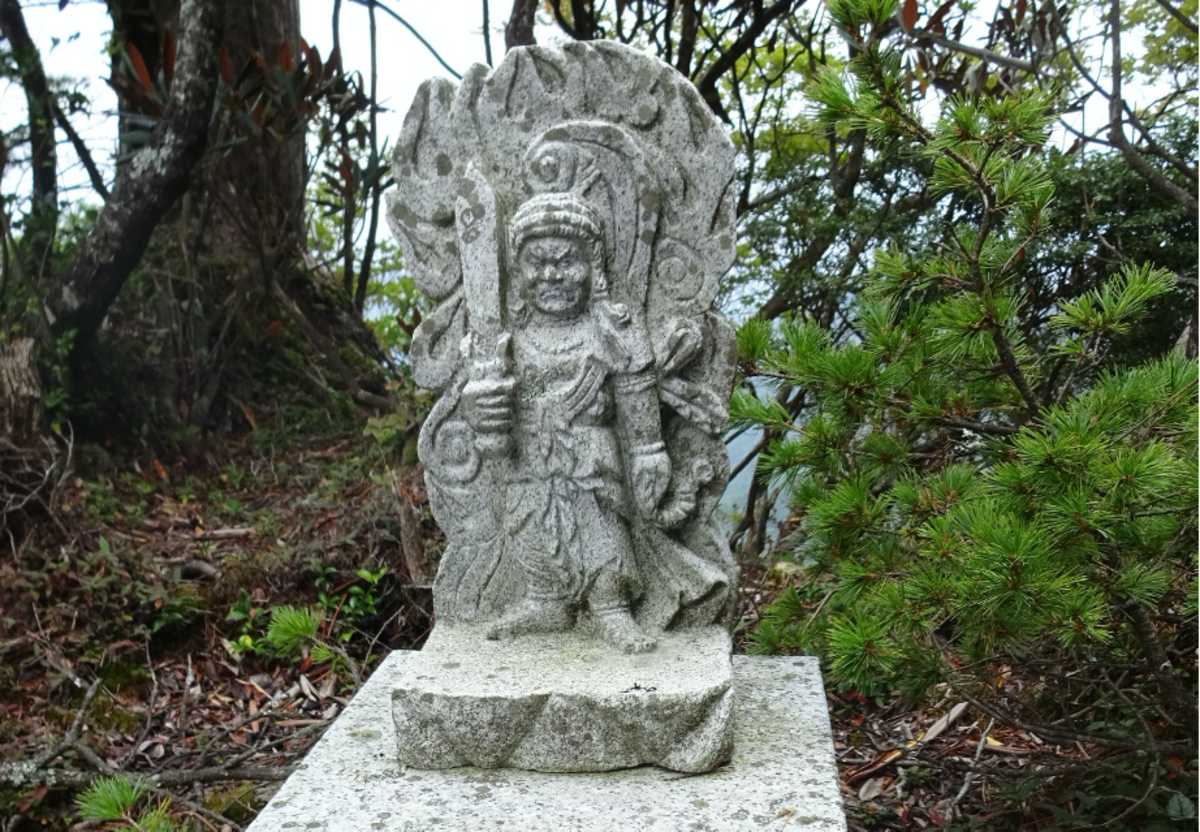
A stone carving of Fudo Myo-o, a Buddhist deity, highly regarded by Shugendo practitioners. These are often found near purifying waterfalls. (Photo: Alena Eckelmann)
While walking or trekking around the area, keep an eye out for depictions of other deities important to Shugendo. Zao Daigongen, the Great Avatar Zao, is a fierce-looking deity venerated as the patron of Yamabushi and the protector of Mount Kimpusen in the Omine Mountain range. This deity appeared to En no Gyoja after 1,000 days of ascetic training. Gongen are considered to be the local kami representation of Buddhist deities. Zao, a unique Japanese deity, represents a trinity of three Buddhist deities that stand for past, present, and future.
Fudo Myo-o, the Immovable Wisdom King, is worshipped as a destroyer of evil and protector of Yamabushi during their training. They identify with it to gain strength and focus during mountain treks. Statues of Fudo-sama are often found near waterfalls where Yamabushi purify.
"On the steep parts of the trail, they can be heard chanting, 'Confess, confess!"
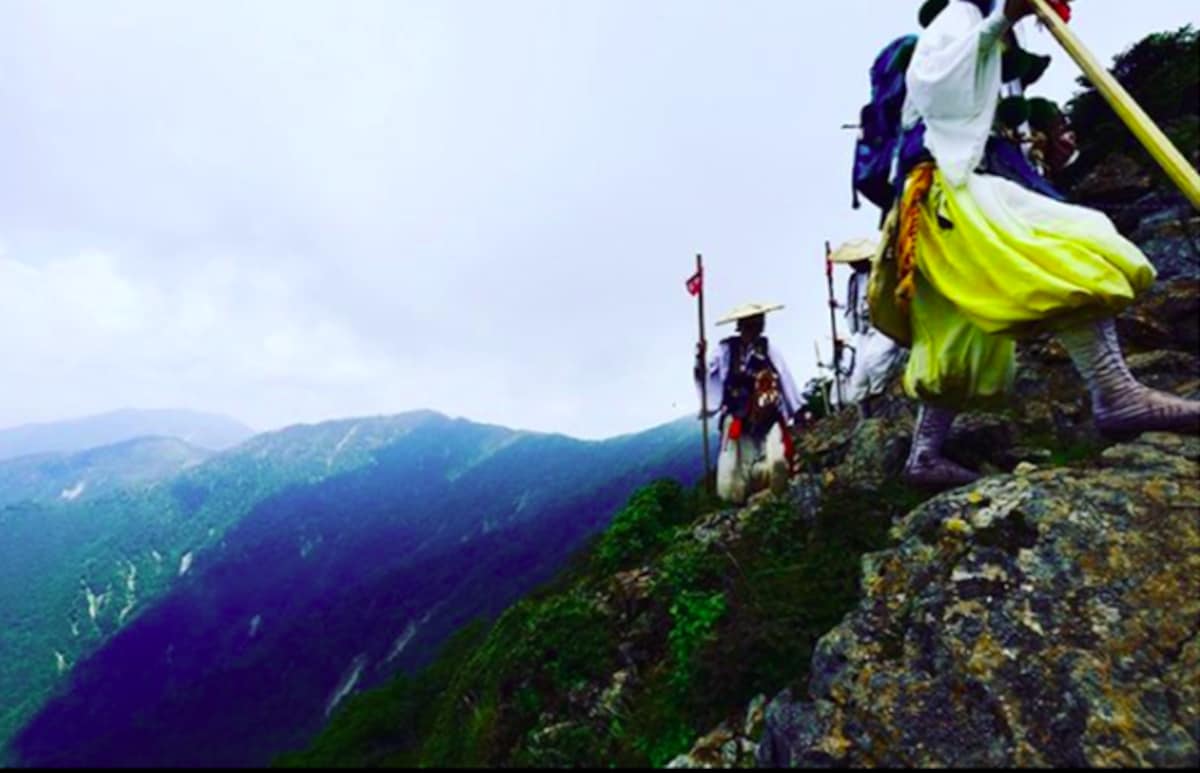
The Okugakemichi, the ascetic training trail of the Yamanushi, connects Yoshinoyama with Kumano over a distance of about 100 kilometers at altitudes between 1000 and 2000 meters. (Photo: courtesy Sakuramotobo temple)
For those interested in experiencing the harsh mountain regime of the ascetics, a trail leads to Ominesanji temple, some 25 kilometers from Yoshinoyama. This temple is a main Shugendo sanctuary and training site at Sanjogatake, a holy peak at 1,719 meters in the Omine mountain range.
A gender ban on the upper trails
Unfortunately, the peak of Sanjogatake and the Ominesanji sanctuary, as well as the trail leading there, have been historically off-limits to women. This prohibition still is in effect today. Wooden gates with the kanji characters “Nyonin Kekkai” (off-limits to women) are set on the trails that lead up to the sacred peak. Women are expected to respect this and not continue their hike through these gates.
A similar ban existed for many sacred mountains in Japan until a governmental decree in the early Meiji era universally lifted it. Yet, the ban remains in effect at Sanjogatake, with defenders of its existence citing “religious tradition” for justification. In 2004, when Ominesanji was nominated to become part of the UNESCO World Heritage Site—Sacred Sites and Pilgrimage Routes in the Kii Mountain Range—women hoped that the ban would be lifted, but their wishes were in vain.
Women today are allowed to walk from Yoshinoyama up to a point called Gobanseki, where they have to descend into Dorogawa, another Shugendo village. All of the trails closer to Yoshinoyama as well as the Shugendo temples there are open to women, and welcome them to experience the faith.
An Annual Pilgrimage for Male Worshipers
Take a Kintetsu Limited Express (77 min; 1,510 yen) train from Osaka’s Abenobashi Station and ride through to the Yoshino Station terminal. The slower and cheaper option is an Express (86 min; 990 yen) whereas the exclusive option is the Blue Symphony, a sightseeing train (only 2 departures per day; reservation needed).
The Yoshinoyama Shugendo temples conduct an annual pilgrimage of those seeking to achieve higher levels of consciousness. The long mountain treks include ritual purification, prayers, and esoteric rituals, all of which require considerable courage and endurance. Yamabushi believe they experience a symbolic death and re-birth in the mountains.
On the steep parts of the trail they can be heard chanting, “Zange, Zange!” (Confess, confess!), followed by “Rokkon shojo!” (Purify your six senses). The ultimate aim is to reach sokushin jobutsu, or gaining enlightenment in this life and this body, which seems impossible to achieve even after a lifetime of training. However, every step on the ground is a step closer in the heart.
Yamabushi do not endure the hardship of training only for themselves but dedicate their practices and their prayers to the well-being of all. Prayers are focused on the present and include wishes for health and safety of their families and the welfare of their communities.
Getting There: Osaka to Yoshinoyama
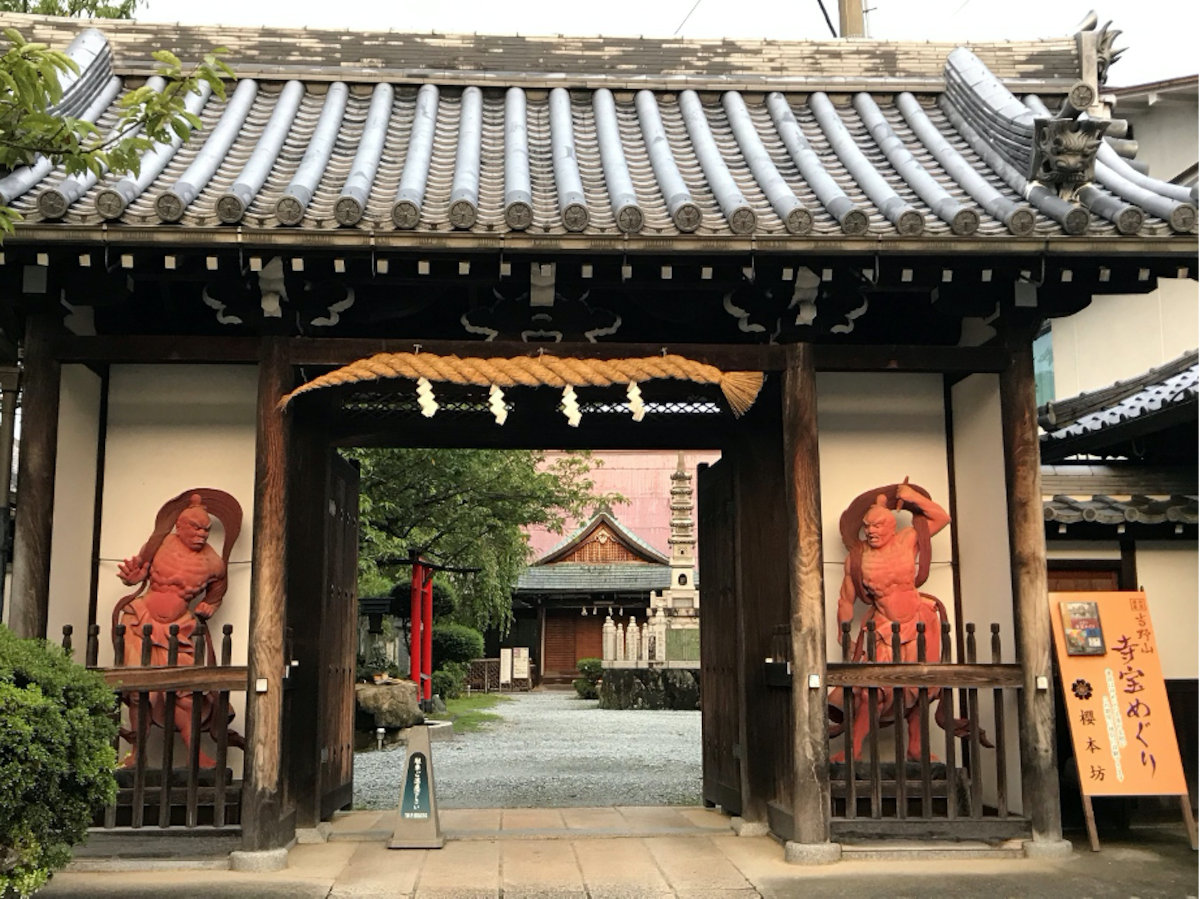
The gate to Sakuramotobo shrine, with the two dramatically posed nio guardians flanking the entrance. (Photo: Alena Eckelmann)
This village of Yoshinoyama, and its Shugendo-related surroundings, is hardly on the beaten path for most tourists. But it is a unique destination for those interested in the spiritual history of Japan, and how ancient ascetic traditions are being kept alive.
There is a bus from Yoshino Station to a number of stops on Yoshinoyama. However, it only runs a few times during the day. Hence, in Yamabushi style it is best to walk! From Yoshino Station walk straight ahead in direction of the Yoshino Cable Car (not in operation most of the year) and follow a small trail the leads uphill. It cuts across a one-lane road on the Nanamagarizaka which winds its way up through a Hydrangea Garden. After 20 min (1.4km) of walking you arrive at the Ohashi red bridge, which marks the entrance of the village. From the bridge keep following the road, which will take you through the whole of Yoshinoyama and up into the mountains from where the ascetic training trail runs to Sanjogatake and beyond.


